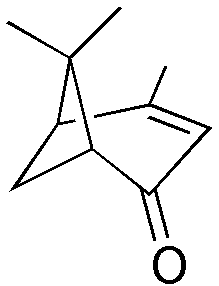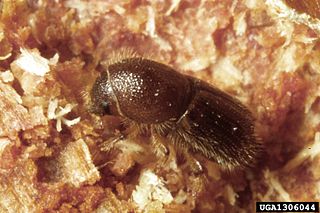
In stereochemistry, stereoisomerism, or spatial isomerism, is a form of isomerism in which molecules have the same molecular formula and sequence of bonded atoms (constitution), but differ in the three-dimensional orientations of their atoms in space. This contrasts with structural isomers, which share the same molecular formula, but the bond connections or their order differs. By definition, molecules that are stereoisomers of each other represent the same structural isomer.

Nepetalactone is a name for multiple iridoid analog stereoisomers. Nepetalactones are produced by Nepeta cataria (catnip) and many other plants belonging to the genus Nepeta, in which they protect these plants from herbivorous insects by functioning as insect repellents. They are also produced by many aphids, in which they are sex pheromones. Nepetalactones are cat attractants, and cause the behavioral effects that catnip induces in domestic cats. However, they affect visibly only about two thirds of adult cats. They produce similar behavioral effects in many other felids, especially in lions and jaguars. In 1941, the research group of Samuel M. McElvain was the first to determine the structures of nepetalactones and several related compounds.

A meso compound or meso isomer is an optically inactive isomer in a set of stereoisomers, at least two of which are optically active. This means that despite containing two or more stereocenters, the molecule is not chiral. A meso compound is superposable on its mirror image. Two objects can be superposed if all aspects of the objects coincide and it does not produce a "(+)" or "(-)" reading when analyzed with a polarimeter. The name is derived from the Greek mésos meaning “middle”.

A bark beetle is the common name for the subfamily of beetles Scolytinae. Previously, this was considered a distinct family (Scolytidae), but is now understood to be a specialized clade of the "true weevil" family (Curculionidae). Although the term "bark beetle" refers to the fact that many species feed in the inner bark (phloem) layer of trees, the subfamily also has many species with other lifestyles, including some that bore into wood, feed in fruit and seeds, or tunnel into herbaceous plants. Well-known species are members of the type genus Scolytus, namely the European elm bark beetle S. multistriatus and the large elm bark beetle S. scolytus, which like the American elm bark beetle Hylurgopinus rufipes, transmit Dutch elm disease fungi (Ophiostoma). The mountain pine beetle Dendroctonus ponderosae, southern pine beetle Dendroctonus frontalis, and their near relatives are major pests of conifer forests in North America. A similarly aggressive species in Europe is the spruce ips Ips typographus. A tiny bark beetle, the coffee berry borer, Hypothenemus hampei is a major pest on coffee plantations around the world.

The mountain pine beetle is a species of bark beetle native to the forests of western North America from Mexico to central British Columbia. It has a hard black exoskeleton, and measures approximately 5 millimetres, about the size of a grain of rice.

Verbenone is a natural organic compound classified as a terpene that is found naturally in a variety of plants. The chemical has a pleasant characteristic odor. Besides being a natural constituent of plants, it and its analogs are insect pheromones. In particular, verbenone when formulated in a long-lasting matrix has an important role in the control of bark beetles such as the mountain pine beetle and the Southern pine bark beetle.

The ant beetle, also known as the European red-bellied clerid, is a medium size insect, rather soft-bodied, with strong mandibles that can tear between the hard sclerotized integument of bark beetles. Larvae and adults are common predators of bark beetles in Europe.

trans-Cyclooctene is a cyclic hydrocarbon with the formula [–(CH2)6CH=CH–], where the two C–C single bonds adjacent to the double bond are on opposite sides of the latter's plane. It is a colorless liquid with a disagreeable odor.

Dendroctonus is a genus of bark beetles. It includes several species notorious for destroying trees in the forests of North America. The genus has a symbiotic relationship with many different yeasts, particularly those in the genera Candida and Pichia that aid in digestion and pheromone production.

In chemistry, isomers are molecules or polyatomic ions with identical molecular formula – that is, same number of atoms of each element – but distinct arrangements of atoms in space. Diamond and graphite are a familiar example; they are isomers of carbon. Isomerism refers to the existence or possibility of isomers.

Lineatin is a pheromone produced by female striped ambrosia beetle, Trypodendron lineatum Olivier. These kinds of beetles are responsible for extensive damage of coniferous forest infestation in Europe and North America. Since lineatin can act as lures used for mass-trapping of T. lineatum, it is being studied to apply as a pest control reagent.

The European spruce bark beetle, is a species of beetle in the weevil subfamily Scolytinae, the bark beetles, and is found from Europe to Asia Minor and some parts of Africa.

Dendroctonus frontalis, the southern pine beetle, often shortened to simply SPB, is a species of bark beetle native to the forests of the southern United States, Mexico and Central America. It has recently expanded its range to the northeastern United States, where it is considered an invasive species and has destroyed massive amounts of pine forest.

(S)-Ipsdienol is a terpene alcohol. It is one of the major aggregation pheromones of the bark beetle. It was first identified from Ips confusus, in which it is believed to be a principle sex attractant. It is suggested that the compound plays a role in interspecies communication between Ips latidens and Ips ini, facilitating reductions in competition for breeding material and/or mating interference.
(−)-α-Pinene synthase is an enzyme with systematic name geranyl-diphosphate diphosphate-lyase [cyclizing, (−)-α-pinene-forming]. This enzyme catalyses the following chemical reaction

Ips is a genus of beetles in the family Curculionidae, the true weevils. They are bark beetles, members of the subfamily Scolytinae. Species are distributed throughout the Northern Hemisphere. Some are known as introduced species in Australia and Africa. Many species are pests of forest trees, especially pines and spruces. They are known commonly as engraver beetles, ips engraver beetles, and pine engravers.

Lavandulol is a monoterpene alcohol found in a variety of essential oils such as lavender oil. The term refers to either of two enantiomers. The (R)-enantiomer is natural and has an aroma described as "weak floral, herbal odor with slightly lemon-like, fresh citrus fruity nuance"; the (S)-enantiomer has only a weak odor.

Dendroctonus valens, the red turpentine beetle, is a species of bark beetle native to the forests of North America, Mexico, Guatemala and Honduras. It has been introduced to China where it has become invasive. In its native range it causes little damage, but in China it is a destructive pest and has killed more than six million pine trees.

Ips pini, also known as the pine engraver or North American pine engraver, is a species of typical bark beetle in the family Curculionidae that exists primarily in North America. Among the broadly distributed species across the entirety of North America, populations of these beetles are further broken down into distinctive geographical ranges with a distinctive feature of how the groups produce the enantiomeric composition of ipsdienol—the major pheromone component produced by males.

Insect pheromones are neurotransmitters that serve the chemical communication between individuals of an insect species. They thus differ from kairomones, in other words, neurotransmitters that transmit information to non-species organisms. Insects produce pheromones in special glands and release them into the environment. In the pheromone receptors of the sensory cells of the recipient, they produce a nerve stimulus even in very low concentrations, which ultimately leads to a behavioral response. Intraspecific communication of insects via these substances takes place in a variety of ways and serves, among other things, to find sexual partner, to maintain harmony in a colony of socially living insects, to mark territories or to find nest sites and food sources.



















